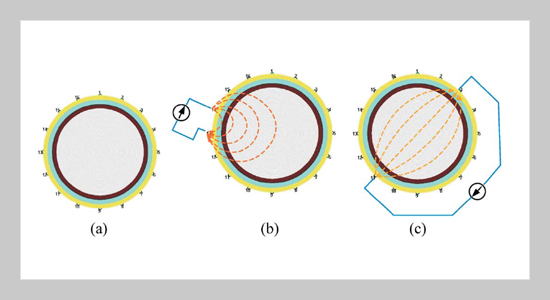REFERENCES
- [1] Tang, C., F. You, G. Cheng, D. Gao, and F. Fu (2008) Correlation between structure and resistivity variations of the live human skull, IEEE Transactions on Biomedical Engineering 55(9), 2286�2292. doi: 10. 1109/TBME.2008.923919
- [2] Hoekema,R., G. H. Wieneke, F. S. S. Leijten, C. W. M. v. Veelen,P. C.v. Rijen, G. J. M.Huiskamp,J. Ansems, and A. C. v. Huffelen (2003) Measurement of the conductivity of skull, temporarily removed during epilepsy surgery, Brain Topography 16(1), 29�38.
- [3] Holder, D. S., A. Rao, and Y. Hanquan (1996) Imaging of physiologically evoked responses by electrical impedance tomography with cortical electrodes in the anaesthetized rabbit, Physiol. Meas. 17, A179–A186. doi: 10.1088/0967-3334/17/4A/022
- [4] Holder, D. (2005) Electrical Impedance Tomography: Methods, History and Applications, Bristol, Institute of Physics. doi: 10.1088/0967-3334/26/4/B01
- [5] Klivington, K. A., and R. Galambos (1968) Rapid resistance shifts in cat cortex during click-evoked responses, J Neurophysiol 31(4), 565�573. doi: 10. 1152/jn.1968.31.4.565
- [6] Dowrick, T., G. S. D. Santos, A. Vongerichten, and D. Holder (2015) Parallel, multi frequency EIT measurement, suitable for recording impedance changes during epilepsy, Journal of Electrical Bioimpedance 6, 37�43. doi: 10.5617/jeb.2573
- [7] Gilad, O., A. Ghosh, D. Oh, and D. S. Holder (2009) A method for recording resistance changes non-invasively during neuronal depolarization with a view to imagingbrain activitywithelectricalimpedancetomography, Journal of Neuroscience Methods 180, 87�96. doi: 10.1016/j.jneumeth.2009.03.012
- [8] Murrieta-Lee, J. C., C. J. D. Pomfrett, P. C. W. Beatty, C. B. Mussel, R. C. Waterfall, N. Polydorides, and H. McCann (2005) EIT voltage changes on the human scalp due to brain stimulus, 15th International Conference on Electronics, Communications and Computers, 2005. doi: 10.1109/CONIEL.2005.38
- [9] McCann, H., N. Polydorides, J. C. Murrieta-Lee, K. Ge, P. Beatty, and C. J. D. Pomfrett (2006) Sub-second functional imaging by electrical impedance tomography, Proceedings of the 28th IEEE EMBS Annual International Conference, New York City, USA. doi: 10. 1109/IEMBS.2006.259504
- [10] McCann, H., S. T. Ahsan, J. L. Davidson, R. L. Robinson, P. Wright, A. Bryan, B.J. Pollard, T. Quraishi, and C. J. D. Pomfrett(2011) Preliminaryobservations with fEITER data under auditory stimulation, Proc. XIIth International Conference on Electrical Impedance Tomography, Univ. of Bath.
- [11] Bayford, R. H., K. G. Boone, Y. Hanquan, and D. S. Holder (1996) Improvementof the positional accuracy of EIT images of the head using a Lagrange multiplier reconstruction algorithm with diametric excitation, Physiol. Meas. 17, A49–A57. doi: 10.1088/09673334/17/4A/008
- [12] Abascal, J.-F. P. J., S. R. Arridge, D. Atkinson, R. Horesh, L. Fabrizi, M. D. Lucia, L. Horesh, R. H. Bayford, and D. S. Holder (2008) Use of anisotropic modelling in electrical impedance tomography; description of method and preliminary assessment of utility in imaging brain function in the adult human head, NeuroImage 43(2), 258�268. doi: 10.1016/j. neuroimage.2008.07.023
- [13] Tidswell, T., A. Gibson, R. H. Bayford, and D. S. Holder (2001) Three-dimensional electrical impedance tomography of human brain activity, NeuroImage 13, 283�294. doi: 10.1006/nimg.2000.0698
- [14] Gilad, O., and D. S. Holder (2009) Impedance changes recorded with scalp electrodes during visual evoked responses: implicationsfor electricalimpedancetomography of fast neural activity, NeuroImage 47, 514� 522. doi: 10.1016/j.neuroimage.2009.04.085
- [15] Tidswell, A. T., A. Gibson, R. H. Bayford, and D. S. Holder (2001) Electrical impedance tomography of human brain activity with a two-dimensional ring of scalp electrodes, Physiol. Meas. 22, 167�175.
- [16] Gilad, O., L. Horesh, and D. S. Holder (2005) Non-invasive imaging of synchronized neuronal activity us
ing low frequency electrical impedance tomography, The 3rd European Medical & Biological Engineering Conference (EMBEC 05), IFMBE, Prague.
- [17] Murrieta-Lee, J. C., C. J. D. Pomfrett, P. C. W. Beatty, N. Polydorides, C. B. Mussel, R. C. Waterfall, and H. McCann (2004) Sub-second observations of EIT voltage changes on the human scalp due to brain stimulus, 26th Annual International Conference of the IEEE Engineering in Medicine and Biology Society (IEMBS ‘04). doi: 10.1109/IEMBS.2004.1403414
- [18] Anas, M. N., A. N. Norali, and M. Rehman (2012) Development of a low cost precision blood resistivity measurement device based on Thompson Lampard Theorem, 2012 International Conference on Biomedical Engineering (ICoBE), Penang. doi: 10.1109/ ICoBE.2012.6178986
















